
KENTUCKY TRANSPORTATION CENTER
176 Raymond Building, University of Kentucky
859. 257. 4513 www.ktc.uky.edu
!
!
!
!
!
!
!
!
!
!
!
!
!
!
!
!
!
!
!
Cost Benefit Analysis: Applications and Future
Opportunities
Kentucky Transportation Center Research Report — KTC-16-04/SPR16-517-1F
DOI: http://dx.doi.org/10.13023/KTC.RR.2016.04

!
KTC’s Mission
We provide services to the transportation community through research, technology
transfer, and education. We create and participate in partnerships to promote safe and
effective transportation systems.
© 2016 University of Kentucky, Kentucky Transportation Center
Information may not be used, reproduced, or republished without KTC’s written consent.
Kentucky Transportation Center
176 Oliver H. Raymond Building
Lexington, KY 40506-0281
(859) 257-4513
www.ktc.uky.edu
!

Research Report
KTC-16-04/SPR16-517-1F
Cost Benefit Analysis: Applications and Future Opportunities
By
Bryan Gibson, Ph.D.
Kentucky Transportation Center
and
Candice Wallace, Ph.D.
Kentucky Transportation Center
Kentucky Transportation Center
College of Engineering
University of Kentucky
Lexington, KY
in cooperation with the
Kentucky Transportation Cabinet
The contents of this report reflect the views of the authors, who are responsible for the facts and accuracy of the data
presented herein. The contents do not necessarily reflect the official views or policies of the University of Kentucky,
the Kentucky Transportation Center, the Kentucky Transportation Cabinet, the United States Department of
Transportation, or the Federal Highway Administration. This report does not constitute a standard, specification, or
regulation. The inclusion of manufacturer names or trade names is for identification purposes and should not
be considered an endorsement.
June 2016

1. Report No.
KTC-16-04/SPR16-517-1F
2. Government Accession No.
3. Recipient’s Catalog No
4. Title and Subtitle
Cost Benefit Analysis: Applications and Future Opportunities
5. Report Date
June 2016
6. Performing Organization Code
7. Author(s):
Bryan Gibson and Candice Wallace
8. Performing Organization Report No.
KTC-16-04/SPR16-517-1F
9. Performing Organization Name and Address
Kentucky Transportation Center
College of Engineering
University of Kentucky
Lexington, KY 40506-0281
10. Work Unit No. (TRAIS)
11. Contract or Grant No.
SPR 16-517
12. Sponsoring Agency Name and Address
Kentucky Transportation Cabinet
State Office Building
Frankfort, KY 40622
13. Type of Report and Period Covered
14. Sponsoring Agency Code
15. Supplementary Notes
16. Abstract
Cost Benefit Analysis (CBA or Benefit Cost Analysis — BCA) is an evaluation tool that state transportation agencies can
use to compare infrastructure project options across transportation modes and gauge if the discounted value of benefits
exceed the costs. CBA lets policymakers compare alternative project proposals to a baseline scenario, or status quo case,
under which no investments are made. CBA is used to select which proposal is the most sensible investment — ideally,
the project that maximizes benefits while minimizing costs should be chosen. As the use of CBA to evaluate projects and
grant applications (e.g., TIGER Discretionary Grants) continues to grow, state transportation agencies must gain
knowledge of CBA methodologies, especially if they want to remain competitive for federal funding. This study
documents historical trends in CBA from literature and past studies, provides background on how CBA’s are performed,
and describes the purpose and basic function of CBAs. The researchers investigated CBA applications and programs that
the Kentucky Transportation Cabinet (KYTC) could potentially use to prioritize projects and identify other investment
opportunities. This report serves as a primer on the basic elements of CBA, describes what costs and benefits are typically
incorporated into analysis, and gives an overview of the formulas that are used to derive costs and benefits. In the
transportation context, most benefits are derived from travel time savings and crash reductions. Typical costs include
construction and subsequent maintenance. Researchers developed a simple workbook application that KYTC personnel
can use run a CBA. The workbook calculates present value of costs and benefits and makes both NPV and BCR available
to the user.
17. Key Words
Cost Benefit Analysis, NPV, BCR, travel time, crash reduction, economic
analysis, transportation infrastructure
18. Distribution Statement
Unlimited
19. Security Classification (report)
Unclassified
20. Security Classification (this page)
Unclassified
21. No. of Pages
47
19. Security
Classification
(report)
iii
TABLE OF CONTENTS
ACKNOWLEDGEMENTS ............................................................................................................ v!
EXECUTIVE SUMMARY ........................................................................................................... vi!
CHAPTER ONE: INTRODUCTION ............................................................................................. 7!
1.1 Study Overview ..................................................................................................................... 7!
1.2 Research Objectives .............................................................................................................. 8!
1.3 Structure of the Report .......................................................................................................... 8!
CHAPTER TWO: LITERATURE REVIEW ................................................................................. 8!
CHAPTER THREE: COST BENEFIT ANALYSIS BACKGROUND ....................................... 12!
3.1 Introduction to Cost Benefit Analysis ................................................................................. 12!
3.2 Benefits ................................................................................................................................ 15!
3.3 Costs .................................................................................................................................... 17!
3.4 Cost Benefit Analysis Methodologies ................................................................................. 18!
CHAPTER FOUR: COST BENEFIT ANALYSIS APPROACHES ........................................... 27!
Highway Economic Requirements System (HERS-ST) ........................................................... 28!
BCA.NET .................................................................................................................................. 29!
TREDIS Multimodal Benefit-Cost Analysis Tool .................................................................... 30!
MicroBENCOST ....................................................................................................................... 33!
StratBENCOST ......................................................................................................................... 33!
California Life-Cycle Benefit-Cost Analysis Model (Cal-B/C) ............................................... 34!
Tool for Operations Benefit/Cost (TOPS-BC) .......................................................................... 37!
Trip Reduction Impacts of Mobility Management Strategies (TRIMMS) Model .................... 38!
CHAPTER FIVE: IMPLEMENTATION AND CONCLUSION ................................................ 40!
iv
REFERENCES ............................................................................................................................. 42!
LIST of FIGURES
Figure 1: Costs and Benefits Framework ...................................................................................... 15!
Figure 2: Minnesota DOT CBA Process ...................................................................................... 20!
Figure 3: Minnesota DOT Example Benefit Calculation ............................................................. 21!
Figure 4: Minnesota DOT Total User Benefits ............................................................................. 22!
Figure 5: Minnesota DOT Example Cost Calculation .................................................................. 23!
Figure 6: Example Cost Benefit Analysis Calculation ................................................................. 26!
Figure 7: CBA Project Matrix ....................................................................................................... 26!
Figure 8: HERS-ST Screenshot .................................................................................................... 29!
Figure 9: BCA.NET Screenshot ................................................................................................... 30!
Figure 10: TREDIS MBCA Screenshots ...................................................................................... 31!
Figure 11: TREDIS MBCA Results ............................................................................................. 32!
Figure 12: Cal-B/C Screenshots .................................................................................................... 36!
Figure 13: TOPS-BC Screenshots ................................................................................................ 38!
Figure 14: TRIMMS Model Screenshot ....................................................................................... 39!
LIST OF TABLES
Table 1: FHWA Benefits and Costs to Consider .......................................................................... 14!
Table 2: Transportation Economics Committee Benefits and Costs ............................................ 14!
Table 3: Travel Time Values ........................................................................................................ 16!
Table 4: Crash Values ................................................................................................................... 17!
Table 5: Emissions Values ............................................................................................................ 17!
Table 6: Comparison of CBA and Economic Impact Analysis .................................................... 27!
Table 7: Cal-B/C Projects ............................................................................................................. 35!
v
ACKNOWLEDGEMENTS
The following individuals contributed greatly to the successful completion of this project through
their participation on the Study Advisory Committee.
David Talley (chair) - Kentucky Transportation Cabinet
Paul Looney - Kentucky Transportation Cabinet
Tonya Higdon - Kentucky Transportation Cabinet
vi
EXECUTIVE SUMMARY
Cost Benefit Analysis (CBA or Benefit Cost Analysis — BCA) is a tool that state transportation
agencies can use to perform economic comparisons of infrastructure improvement projects across
transportation modes to determine if a project is a justified investment. CBA lets policymakers
compare alternative project proposals to a baseline scenario, or status quo case, under which no
investments are made. Alternative proposals can also be contrasted with one another. CBA is used
to select which proposal is most sensible — ideally, the project that maximizes benefits while
minimizing costs should be chosen. To facilitate comparison between projects, CBA accounts for
costs and benefits of projects and discounts those in present value terms.
CBA has increasingly been applied to the evaluation of transportation infrastructure projects. Some
federal grant programs, such as Transportation Investments Generating Economic Recovery
(TIGER) Discretionary Grants, require that proposers submit CBA to demonstrate a project’s
expected cost-to-benefit ratio. Despite the increased use of CBA, there are no universal standards
that guide their performance. While most CBAs include similar parameters, there are a number of
programs and methodologies used to conduct them. Additionally, when calculating a CBA there
is some level of subjective judgment that is exercised to determine the costs and benefits associated
with the project being analyzed. This study investigated CBA applications and programs that the
Kentucky Transportation Cabinet (KYTC) could potentially use to prioritize projects and identify
other investment opportunities.
The study reviews literature and past studies on CBA and provides background on how CBAs are
performed. This report serves as a primer on the basic elements of CBA, describes what costs and
benefits are typically incorporated into analysis, and gives an overview of the formulas that are
used to derive costs and benefits. Individuals with limited background and understanding of CBA
should be able to quickly grasp the main concepts after reading this document.
In the transportation context, CBA has several limitations, such as omitting costs or key benefits.
Measuring changes in certain factors like travel time savings and safety improvements that reduce
the number of crashes are not easily converted into a single quantifiable (i.e., monetized) metric.
We also distinguish between CBA and economic impact analysis — an economic impact analysis
differs from CBA in that it measures the dollar value of impacts such as jobs created by a specific
project. Further, the report explores the various inputs required for CBA and the costs and benefits
typically associated with transportation projects. We provide examples of each (e.g., construction
and maintenance costs, emissions reductions, safety improvements (crash reduction), and vehicle
miles travelled). CBA outputs are also discussed such as Net Present Value and Benefit-Cost Ratio.
A number of applications that are used to perform CBAs are discussed, with screenshots of some
of these programs included so readers can understand their templates. After evaluating the options
currently available on the market, the research team decided the best course of action was to create
a modified Excel workbook that KYTC can use to execute CBA. This workbook is based on
Caltrans’ Life-Cycle Benefit-Cost Analysis Model. It is a standalone document that accompanies
this report.

7
CHAPTER ONE: INTRODUCTION
1.1 Study Overview
Cost Benefit Analysis (CBA or Benefit Cost Analysis — BCA) is a tool that state transportation
agencies can use to perform economic comparisons of infrastructure improvement projects across
transportation modes to determine if a project is a justified investment. It can inform long-term
planning processes by letting policymakers compare the costs and benefits associated with a range
of alternative projects. Often, such analysis is not part of the decision-making process but if
capabilities existed it could become an integral part of that process. Additionally, some grant
opportunities require a CBA as part of the application. Since detailed CBA analyses that present
accurate and defensible results are an important part of many application packages, reviewing and
detailing CBA methods is beneficial. A number of programs and methodologies have been
developed to execute CBAs. As a result, there are no consistent, clear guidelines or best practices
for CBA.
When prioritizing and selecting projects, return on investment is a key factor to consider. CBA
gives agencies a way to calculate the benefits and costs of projects. Once the costs and benefits
have been estimated, projects may be analyzed individually or, more often, alternative proposals
are compared to one another. CBA can illuminate whether a project is justified from an economic
perspective and thus is a worthwhile investment. CBA is useful for evaluating transportation
projects that meet the following criteria:
1. “The potential project expenditure is significant enough to justify spending resources on
forecasting, measuring and evaluating the expected benefits and impacts.
2. The project motivation is to improve the transportation system's efficiency at serving travel
and access-related needs, rather than to meet some legal requirement or social goal.
3. Environmental or social impacts that are outside of the transportation system efficiency
measurement are either: (a) negligible in magnitude, (b) measurable in ways that can
be used within the benefit-cost framework, or (c) to be considered by some other form of
project appraisal outside of the benefit-cost analysis.”
1
Some key questions that CBA can help answer/address are (Lawrence et al., 2014):
• Should a project be undertaken?
• When should a project be undertaken?
• Which projects and/or project alternatives should be funded?
• Evaluation of project performance.
CBA can be used to determine which among a range of project alternatives will produce the most
economic benefit. CBA can also help develop project and grant priorities. For example, CBA is a
required component of Transportation Investment Generating Economic Recovery (TIGER)
grants.
2
By developing benefit and cost estimates, policymakers gain a clearer picture of how to
1
http://bca.transportationeconomics.org/home/when-to-use-benefit-cost-analysis
2
“The Transportation Investment Generating Economic Recovery, or TIGER Discretionary Grant program,
provides a unique opportunity for the DOT to invest in road, rail, transit and port projects that promise to achieve

8
allocate funds if return on investment is a key factor to consider when prioritizing projects. If direct
comparison tools are lacking for projects such as those across different modes, CBA can be
utilized.
1.2 Research Objectives
This study investigates CBA applications and programs the Kentucky Transportation Cabinet
(KYTC) can use to assist with project prioritization and other opportunities. To develop accurate
and supportable CBA for projects and grant proposals, it is important to analyze all CBA methods
and practices. Based on the scope and data available for projects, methodology and desired outputs
may vary. This background information can assist the KYTC in selecting tools to develop realistic
cost and benefit estimates that will withstand scrutiny and meet the basic requirements previously
detailed.
1.3 Structure of the Report
Chapter 2 is a literature review that discusses, among other things, past studies on CBA, including
a study that details the impact of CBA on TIGER grant awards. Chapter 3 introduces CBA, which
is followed by a discussion of costs and benefits. TIGER Grant guidelines are used to exemplify
valuations of common costs and benefits. Following this, the research team reports on what steps
are needed to perform a CBA by leveraging guidance from the Minnesota Department of
Transportation and several other sources. Metrics used to compare costs and benefits across
projects, such as net present value, are enumerated. Lastly, differences between CBA and
economic impact analysis are noted. Chapter 4 reviews various CBA programs that KYTC can use
to inform its CBAs, including models developed by the Federal Highway Administration (FHWA)
and California’s Department of Transportation. Chapter 5 presents concluding suggestions and
information regarding the Excel workbook developed for KYTC.
CHAPTER TWO: LITERATURE REVIEW
Historically, CBA has not been widely applied to transportation projects. Barriers to using it have
included data needs, resource use, and political factors (Government Accountability Office, 2005).
However, as pressure has increased to maximize the benefits of public funding, CBA been used
with increasing regularity to justify project selections (Section 1909 Commission Staff, 2007).
Rapid growth in the adoption of CBA by federal agencies can be traced to executive orders issued
during the Reagan and Clinton administrations (Adler & Posner, 1999). Executive Order 12866,
issued by President Clinton, mandated that agencies perform a CBA to scrutinize any regulation
or action that affects the economy by $100 million or more each year:
In deciding whether and how to regulate, agencies should assess all costs and
benefits of available regulatory alternatives, including the alternative of not
regulating. Costs and benefits shall be understood to include both quantifiable
measures (to the fullest extent that these can be usefully estimated) and qualitative
national objectives. Since 2009, Congress has dedicated nearly $4.6 billion for seven rounds of TIGER to fund
projects that have a significant impact on the Nation, a region, or a metropolitan area.”
https://www.transportation.gov/tiger/about
9
measures of costs and benefits that are difficult to quantify, but nevertheless
essential to consider. Further, in choosing among alternative regulatory approaches,
agencies should select those approaches that maximize net benefits (including
potential economic, environmental, public health and safety, and other advantages;
distributive impacts; and equity), unless a statute requires another regulatory
approach (Executive Order, 12866).
President Obama issued Executive Order 13563 to reaffirm the Executive Order 12866’s basic
framework:
As stated in that Executive Order and to the extent permitted by law, each agency
must, among other things: (1) propose or adopt a regulation only upon a reasoned
determination that its benefits justify its costs (recognizing that some benefits and
costs are difficult to quantify); (2) tailor its regulations to impose the least burden
on society, consistent with obtaining regulatory objectives, taking into account,
among other things, and to the extent practicable, the costs of cumulative
regulations; (3) select, in choosing among alternative regulatory approaches, those
approaches that maximize net benefits (including potential economic,
environmental, public health and safety, and other advantages; distributive impacts;
and equity); (4) to the extent feasible, specify performance objectives, rather than
specifying the behavior or manner of compliance that regulated entities must adopt;
and (5) identify and assess available alternatives to direct regulation, including
providing economic incentives to encourage the desired behavior, such as user fees
or marketable permits, or providing information upon which choices can be made
by the public (Executive Order, 13563).
CBA has been used in a number of contexts, such as the Environmental Protection Agency (EPA),
where it has increased the agency’s transparency with respect to project impacts and prioritization.
As the private sector becomes more involved in the delivery of government-funded projects there
will be a need to routinely perform CBAs to evaluate their anticipated public benefits.
Limitations of Cost Benefit Analysis
Agencies must consider a number of factors and limitations when they conduct a CBA. It can be
challenging to accurately estimate the value of costs and benefits associated with a project (Guo
et al., 2008). Status-quo base cases must be developed with extreme care — if these are incorrect,
subsequent calculations will also be inaccurate. Agencies should avoid bundled CBAs, which
evaluate the costs and benefits across multiple projects using a single analysis. The benefits and
costs for each project may not be transparent (i.e., they may be hidden by other projects. When
estimating benefits and costs, the potential for omission always exists. A prime example of this is
neglecting to count benefits and costs that may accrue beyond an agency’s jurisdiction.
Calculations must avoid double-counting benefits that may already be captured (such as economic
benefits within reductions in congestion) as well.
Travel time savings and crash reductions (safety improvements) are the benefits most frequently
realized from transportation projects (Kulkarni et al., 2004). However, it can be difficult to measure
10
the changes in these two factors. “With regard to estimating the change in the pre-project impact
levels, many factors besides the project improvement impact such parameters as travel time and
accident frequency, and assessing the effect of such project improvement is often difficult”
(Kulkarni et al., 2004 p. 151). For example, variability in travel times may be omitted from CBAs
despite unreliability in travel times imposing significant costs on motorists (Peer, Koopmans, &
Verhoef, 2012). A number of scholars have indicated that variable costs can be an important factor,
accounting for 10 to 15 percent of travel time costs (Eliasson, 2006; Fosgerau et al., 2008). Peer
et al. (2012) used both an expected constant travel time for a particular road over a certain time
period and travel times based on factors that are unique to a certain day such as weather. They
argued that mean travel time can be used to predict variable travel times and that longer delays are
related to higher variability. Benefits like improved rideability may also be difficult to measure by
a CBA because they are not easily quantified.
A single project is sometimes framed as combinations of several smaller interrelated projects,
which makes developing a comprehensive CBA problematic (Lawrence et al., 2014). Inaccurate
or missing data, an inconsistent or methodologically unsound framework, or the absence of tools
to facilitate analysis can also pose significant obstacles when performing a CBA. These issues can
lead to omitted values, double counting, inaccurate discounting, and other errors that undermine a
CBA’s usefulness. Questions have been raised about how to value time savings versus human lives
in the context of transportation safety projects (Hauer, 2011). By discounting the value of deaths
prevented by safety improvements, Hauer argues that CBA can produce results biased against
projects that emphasize safety. Policymakers should also keep in mind that a CBA is a decision
tool — it does not favor outcomes on moral grounds (Adler & Posner, 1999). Many agencies do
not perform CBAs because there are few resources available to do so once the challenges of
mandatory planning, environmental analysis, and other assessments have been tackled. Political
influence can dampen the influence of CBAs as well, which is a result of competing constituencies
and interest groups lobbying for specific projects irrespective of their costs and benefits.
CBA has limitations when applied to large-scale projects, such as statewide highway plans
(Kulkarni et al., 2004). But it has been used to measure the impacts of significant corridor projects
(Balducci, 2012), intercity bus service (Guo et al., 2008), and winter maintenance approaches
(Veneziano et al., 2010) through road weather management (RWM) programs (Lawrence et al.,
2014). Because transportation projects often generate impacts outside of the local area in which
they are constructed, properly delineating the area that should be included in a CBA is critical
(Bartin et al., 2012). The geographic area analysis that is focused on significantly influences
results. For example, traffic levels can affect how specific projects are valued. As such, projects
focused on rural areas may yield fewer calculated benefits; policymakers may use this information
to argue projects in areas with low traffic do not merit funding because projects in more populated
areas will produce greater returns. When examining a statewide plan, there are a large number and
variety of projects that improve various facets of the transportation system. Projects in different
regions may also have differences in construction costs, which can affect a CBA. Geographic
variability is likely to be more problematic for states with a large footprint.
11
Advantages of Cost Benefit Analysis
Despite its potential limitations, from a budgetary perspective CBA is a more reliable way to rank
maintenance and rehabilitation projects than approaches such as a worst-first ranking (Menendez
et al., 2013). Problems arise over the ability of the organization, particularly smaller organizations,
to conduct a CBA and the data needed for inputs. Incomplete data can have significant impacts on
the sensitivity of CBA (Williges & Mahdavi, 2008). CBA may be inappropriate if projects have to
meet legal requirements that a typical CBA is unable to capture, such as safety, addressing equity
concerns, and maintaining or renovating existing infrastructure (often a base case scenario).
Because a CBA is not a dynamic analysis, there can be questions of optimal timing when selecting
infrastructure projects (Godinho & Dias, 2012). Some researchers have raised questions about
when CBAs are executed during project development. If they are completed too late in the planning
process or require so much information that comprehensive planning has already taken place, they
may not be helpful to transportation agencies (Beukers et al., 2012).
Another potential issue with CBA relates to their treatment of the distribution of benefits among
various population and income groups (Brent, 1996). Traditionally, stakeholders that may either
reap benefits or suffer costs include people who use infrastructure, the agency responsible for the
project, and the community (Sallman et al., 2012; see Table 1). Martens (2011, p. 961) proposed
that an equity analysis should accompany a CBA. The equity analysis should ask three questions:
1) Which goods and bads or benefits and costs should be at the focus of the equity
analysis?
2) How should ‘members of society’ be conceptualized, i.e. which population groups
should be distinguished?
3) What constitutes a ‘morally proper distribution’, i.e. which yardstick or distributive
principle should be used to determine whether a particular distribution is fair?
Evaluating a CBA from an equity perspective decomposes the benefits and costs of a project, and
it reveals how costs and benefits are distributed among various populations (e.g., pollution affects
different age groups differently). Once there has been a decision about what costs and benefits to
focus on, the analysis can divide the population into appropriate demographic segments. For
example, straight benefits could be divided by income or other measures, mobility benefits divided
by car ownership and income, and individual benefits by criteria that are relevant to each benefit
and cost under consideration. Several factors can be used to determine what an acceptable
distribution of benefits and costs looks like. Benefits and costs can be equally distributed among
all demographics. An equity perspective would discourage saddling particular demographics with
either disproportionate costs or benefits. Equalizing benefits and costs can be considered where
benefits and costs are distributed in an effort to narrow existing societal differences. This can also
be considered a compensatory approach that redistributes wealth (Schofield, 1987). If
policymakers want to include these additional parameters, then it is customary to supplement CBA
results with an equity analysis, although the latter is separate from the basic CBA results
(Levinson, 2002).
CBA has been used as criteria for awarding TIGER grants. Homan et al. (2014) explored what role
CBAs played in awarding of the first round of TIGER grants. The multi-layered review process

12
consisted of evaluation, economic analysis, and control and calibration review teams. Evaluating
the proposals of awardees and non-awardees along several analytical axes, the authors found that
some aspects of the CBA, such as quality and expected benefits, were insignificant factors. Projects
that funded transit were found to be significant (more likely to receive funding) along with projects
that showed additional shared funding. However, the most important factor was whether the
project was forwarded to an additional evaluation team, referred to as a Control and Calibration
Team (p.48).
Ultimately, the single most important factor was whether a special Control and
Calibration Team had forwarded a project to the RT (Review Team). This team
relied on other considerations besides the published primary and secondary
evaluation criteria used by the Evaluation Team. We found that the outcome of the
BCA and likelihood of net social benefits were significantly lower for projects
forwarded by the Control and Calibration Team vis-a-vis than those forwarded by
the Evaluation Team. When analyzing only the projects forwarded by the
Evaluation Team we found that the quality (outcome) of the BCA was significantly
better for projects that received a grant. At the margin, this might indicate that the
RT did consider the quality of a BCA somewhat in deciding whether to award a
project when the Evaluation Team forwarded projects based on the accepted
criteria.
While this analysis of early TIGER grant awards did not indicate that CBA was a significant factor,
it is important to note that if CBA included with a proposal did not hold up under scrutiny with the
Economic Analysis Team, then that information was transmitted to the Review Team along with
recommendations from the Evaluation Team.
CHAPTER THREE: COST BENEFIT ANALYSIS BACKGROUND
3.1 Introduction to Cost Benefit Analysis
In a transportation context, CBA is used to calculate project benefits and costs to decide whether
a project can be financially justified. They are also used to compare alternative scenarios and/or
projects.
3
The Minnesota Department of Transportation’s (MNDOT) Planning and Programming
Section describes CBA in the following manner:
A benefit-cost analysis is a systematic evaluation of the economic advantages
(benefits) and disadvantages (costs) of a set of investment alternatives. Typically,
a “Base Case” is compared to one or more Alternatives (which have some
significant improvement compared to the Base Case). The analysis evaluates
incremental differences between the Base Case and the Alternative(s). In other
words, a benefit-cost analysis tries to answer the question: What additional benefits
will result if this Alternative is undertaken, and what additional costs are needed to
bring it about?
4
3
http://bca.transportationeconomics.org/
4
http://www.dot.state.mn.us/planning/program/benefitcost.html#section2

13
The Transportation Economics Committee of the Transportation Research Board (TRB) defines
CBA as a tool for economic evaluation that “uses monetized (measured in monetary units) values
to compare total incremental benefits with total incremental costs.”
5
CBA accounts for changes in
benefits and costs compared to the status-quo across the project’s lifecycle. This provides initial
information as to whether the project should be undertaken at all (benefits>costs). Once this first
measure has been completed, a CBA can discriminate among alternative project options along the
same roadway or evaluate the costs and benefits of competing projects located on different
roadways. According to the Transportation Economics Committee, CBA is most applicable for
projects that:
• Are large enough to justify the price of a thorough analysis
• Improve transportation systems rather than altering them to meet legal requirements or
some other measure
• Have environmental costs which are insignificant or can be assigned monetary values to
include in the analysis.
To analyze all years of a project’s lifecycle, a discount rate is used to derive benefits and costs.
The discount rate measures the “marginal social opportunity cost of funds allocated to public
investment” (Zhuang et al., 2007, p. 1).
Generally, benefits accrue over a number of years while most costs are incurred up front during
the initial construction. Smaller annual maintenance costs accumulate over the life of the asset.
CBA assigns benefits dollar values and discounts them in order to calculate the cost-benefit ratio.
“The primary transportation-related elements that can be monetized are travel time costs, vehicle
operating costs, safety costs, ongoing maintenance costs, and remaining capital value (a
combination of capital expenditure and salvage value).”
6
CBA is conducted at various points
during project development and can supplement other project development measures, such as
public input. Additionally, CBA is not used strictly for infrastructure analysis. It can measure the
costs and benefits of projects related to management and operations (Sallman et al., 2012).
When conducting CBA, the selection and valuation of appropriate benefits and costs is critical to
the process. Failing to identify all relevant costs and benefits may produce inaccurate results. The
FHWA lists common benefits and costs that are often investigated when conducting CBA (Table
1)
7
.
5
http://bca.transportationeconomics.org/home/when-to-use-benefit-cost-analysis
6
http://www.dot.state.mn.us/planning/program/benefitcost.html#section2
7
http://www.fhwa.dot.gov/infrastructure/asstmgmt/primer05.cfm

14
Table 1: FHWA Benefits and Costs to Consider
Agency Costs
Design and Engineering
Land Acquisition
Construction
Reconstruction/Rehabilitation
Preservation/Routine Maintenance
Mitigation
Users
(work zones)
Delay
Crashes
Vehicle Operating Costs
Users
(operations)
Travel Time and Delay
Crashes
Vehicle Operating Costs
Externalities
Emissions
Noise
Other
TRB’s Transportation Economics Committee also lists a number of benefits and costs to evaluate
(summarized in Table 2).
8
Table 2: Transportation Economics Committee Benefits and Costs
Benefits
Travel time
Vehicle cost savings
Safety improvements (crash reduction)
Emissions reductions
Parking savings (if project reduces vehicle ownership/use)
Costs
Initial costs (acquisition, planning, design, engineering, and construction)
Continuing costs (operations, maintenance)
Rehabilitation costs
End of project costs (residual value, salvage value)
Figure 1 (Balducci 2012, p. 2-2, Figure 2-2) illustrates a more complex accounting of benefits and
costs in a corridor analysis.
8
http://bca.transportationeconomics.org/home
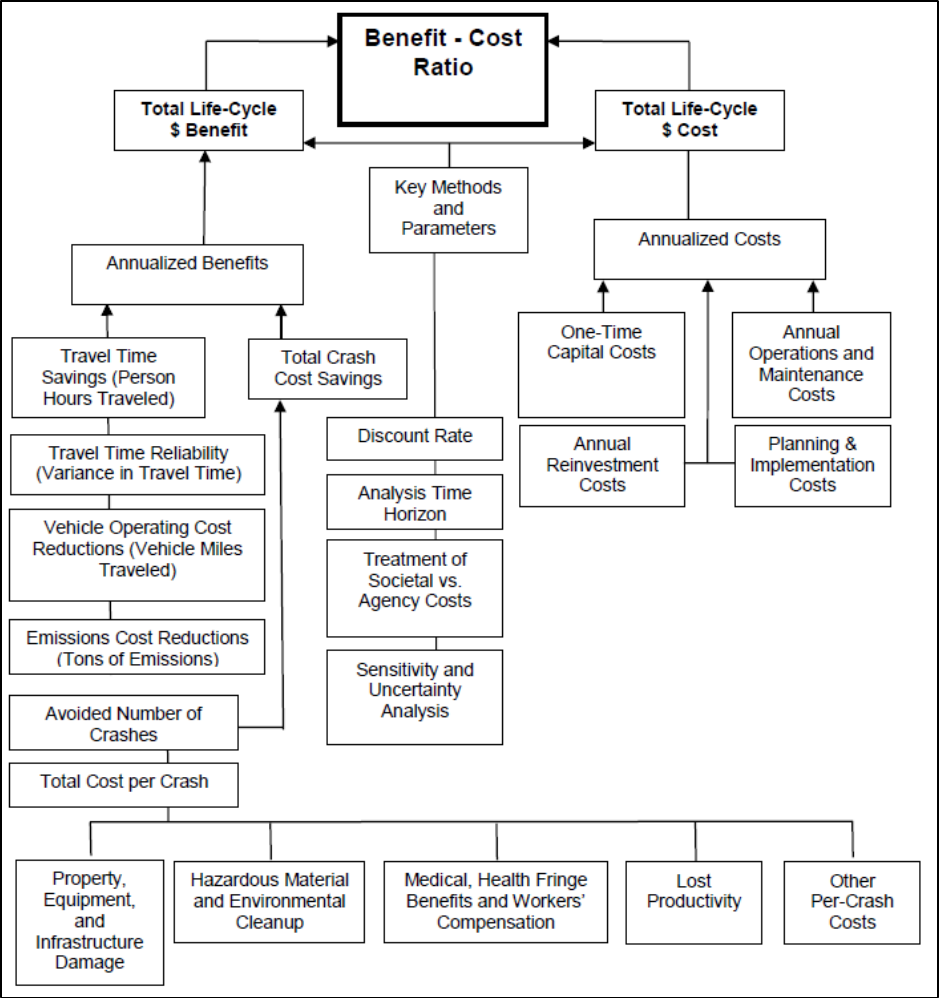
15
Figure 1: Costs and Benefits Framework
3.2 Benefits
Sullivan et al. (2008) listed the four benefits most commonly realized from transportation projects.
These are: travel time savings, a reduction in vehicle operating costs, improved safety, and reduced
emissions. Williges and Mahdavi (2008) noted that outside of travel time savings, operating costs,
and safety, other benefits are often bracketed as externalities because they are not part of travel
decision making. Assigning values and developing accurate data and measures for these potential
benefits is often difficult, and many times they are not included in CBA. Many of the benefits and

16
costs that should be considered are easily identifiable. For example, a reduction in crashes (and/or
crash severity) benefits users by shrinking travel times, reducing vehicle operating costs, and
preventing injuries and fatalities (which can be assigned a monetary value). Minnesota DOT notes
that travel time savings are often the greatest project benefit, generally expressed in terms of
vehicle-hours travelled. Section 1909 Commission Staff (2007) described the valuation of travel
time as follows (p.5):
An hour of travel associated with a business trip or commerce is usually valued at
the average traveler's wage plus overhead—representing the cost to the traveler's
employer. Personal travel time (either for commuting or leisure) is usually valued
as a percentage of average personal wage based on estimates of what travelers
would be willing to pay to reduce their travel time.
During CBA, estimates of travel times prior to and after project implementation demonstrate the
total change in travel time which can be attributed to a specific project alternative. More exactly,
the annual benefits that stem from a reduction in vehicle-hours travelled equals the total annual
hours saved multiplied by the hourly value of time, which varies based on the type of travel and
mode of travel. Projects are designed to reduce congestion (e.g., adding a lane), reduce travel time,
and potentially reduce vehicle costs. TIGER Grants have an accompanying Benefit-Cost Resource
Guides
9
with updated values of travel time in 2013 dollars.
10
These are shown below in Table 3.
Table 3: Travel Time Values
Type
Surface Modes
(excluding High Speed
Rail)
Air and High
Speed Rail
Local
Personal
$12.42
Business
$25.23
All (weighted averages 95.4% person, 4.6%
business)
$12.98
Intercity
Personal
$17.39
$33.05
Business
$24.44
$60.74
All (weighted averages 78.6% personal,
21.4% business for surface; 59.6% personal,
40.4% business for air and high speed rail )
$18.90
$44.24
Vehicle operating costs can result from changing travel distance, the number of stops, and altering
roadway conditions. At a micro level, analysis can focus on the type of vehicle, speed, changes in
speed, grade and curve of route travelled, and road surface condition. Safety improvements can be
measured by valuing crashes (severity), the changes which result from improvements, and trends
in accident costs. Crash elements investigated often include property damage, traffic delay, lost
9
https://www.transportation.gov/sites/dot.gov/files/docs/TIGER%20BCA%20Resource%20Guide%202014.pdf.

17
wages, pain, and emergency services. Table 4 summarizes the values assigned for loss of life and
injuries of different scenarios found in the TIGER Benefit-Cost Resource Guide.
Table 4: Crash Values
Value of Statistical Life (VSL)
$9.2 million per fatality
Value of Injuries
Severity
Fraction of VSL
Value
Minor
0.003
$27,600
Moderate
0.047
$432,400
Serious
0.105
$966,000
Severe
0.266
$2,447,200
Critical
0.593
$5,455,600
Property Damage Only
$3,927 per vehicle
A cutback in emissions is another potential benefit of transportation projects. If a proposed project
reduces travel time and miles travelled, emissions will decline, yielding health and environmental
benefits. However, the linkage between different types of emissions and their levels is less clear.
Once a CBA estimates the changes in traffic activity that will result from a project, the implications
for emissions can be assessed, and changes in emissions can be monetized based on recommended
values. Emission values from the TIGER Benefit-Cost Resource Guide are shown in Table 5.
Table 5: Emissions Values
Emission
Dollars per metric ton
Carbon dioxide
$39*
Volatile Organic Compounds
$1,999
Nitrogen Oxides
$7,877
Particulate Matter
$360,383
Sulfur Dioxide
$46,561
*Social cost of carbon (3%) is present value of marginal future climate damage
Additional benefits to consider when developing a CBA include: induced travel changes resulting
from a project (changes in route, mode, travel time, new trips), changes in travel time reliability
(measure and value needed), the negative impact of construction on overall benefits (additional
costs due to congestion, diversion, and so forth during construction), noise, and parking impacts
of certain projects. Many of these benefits are more difficult to estimate or only apply to certain
types of projects.
3.3 Costs
Agency, or project, cost is the amount of money needed to complete a specified project (Tables 1
and 2). Initial costs are incurred from the design and construction phases. If resources already in
use — such as engineering staff — are diverted to a project, a CBA should include the opportunity
cost of those resources. Sunk costs (i.e., resources that are already owned and lack any opportunity
cost) should be excluded from calculations. After construction is finished on a project, there are
continuing costs, which may encompass traffic management, tolling operations, maintenance, and
rehabilitation (e.g., resurfacing or major repairs that general maintenance would not cover). When
18
the project reaches the end of its lifecycle, a residual or salvage value may exist. This value will
vary among projects and is partially offset by final costs associated with project closeout.
Costs must include those related to construction and future maintenance (Minnesota DOT, 2012).
As such, capital, major rehabilitation, and annual maintenance costs should be factored into CBAs.
Costs generally appear straightforward, including initial construction costs and maintenance costs
over the life of the project. However, other considerations when determining costs are (Sullivan et
al., 2008, p. 284):
• Discounting of future costs (and benefits), including selection of the discount rate
• Dealing with opportunity costs
• Dealing with inflation, and the distinction between economic and financial analyses
• Proper treatment of transfer payments and avoidance of double counting
• Avoidance of sunk costs
• Dealing with joint costs
• Dealing with uncertainty and the role of sensitivity analysis
Additional variables may influence benefits and costs, but are difficult to value. These include
changes in travel patterns due to the project, noise pollution or abatement, environmental impacts
to habitats and water quality, economic and other impacts on surrounding community, and traffic
impacts during construction (e.g., increased congestion or diversions). Benefits that are less certain
may be documented by interviewing and surveying affected population demographics.
Also difficult to calculate are the residual value of the asset that remains after its lifecycle has
ended and the impact of externalities on people who do not benefit from the project. Economic
Development Research Group (2010) defines residual value as: “The value of an investment as a
benefit after: (1) depreciating the investment to the end of the BCA analysis period, and then (2)
discounting the depreciated nominal value” (p. 23). Subtracting cumulative depreciation over the
life of the asset and applying the discount rate yields its residual value. Positive and negative
externalities can result from projects. Valuing these is often difficult, and may not be possible in
some cases (e.g., emissions). Environmental impacts such as emissions may be calculated based
on EPA data. In cases where no dollar amount can be assigned, qualitative perceptions of
externalities may integrated into CBA.
3.4 Cost Benefit Analysis Methodologies
Generally, transportation projects are designed to meet objectives such as increased road capacity,
crash reductions, or some other goal. Many projects have multiple objectives, and these will need
to be accounted for by CBA. Constraints may include policy and legal impediments to the proposed
project. When developing a CBA, the first step is to identify the costs and benefits of the base case,
which is the minimal option wherein operations continue without any major capital investment.
The base case scenario is then compared to different project options (e.g., rehabilitating or entirely
reconstructing a deteriorating road), specifically, the costs and benefits that would be realized
under each scenario. The period for analysis includes the alternatives’ lifecycles, ensuring that the
CBA captures all benefits and costs. Then, dollar amounts are assigned to the benefits and costs
and discounted appropriately. If an analyst is uncertain about the specific impacts of a project (and

19
therefore its costs and benefits), the likelihood of CBA generating an error increases, which makes
the prospect of doing comparisons shaky.
We review and summarize several sources that describe the application of CBA to transportation,
including the FHWA’s Economic Analysis Primer on Benefit-Cost Analysis and the Minnesota
DOT’s Benefit-Cost Analysis for Transportation Projects, below.
The FHWA lists the major steps in the CBA process
11
:
1. Establish objectives
2. Identify constraints and specify assumptions
3. Define base case and identify alternatives
4. Set analysis period
5. Define level of effort for screening alternatives
6. Analyze traffic effects
7. Estimate benefits and costs relative to base case
8. Evaluate risk
9. Compare net benefits and rank alternatives
10. Make recommendations
Guo et al. (2008, p. 4-5) synthesized a novel approach to CBA based on several sources:
1. Define the base case and the options
2. Identify the scope of the CBA
3. Identify investment impacts within the scope
4. Measure the impacts and convert them into dollar values
5. Calculate the net present value for the options proposed
6. Conduct sensitivity and/or risk analyses
7. Make funding decisions based on the information gathered
Although a number of other sources provide guidance on CBA, they usually mirror the approaches
noted. There appears to be consensus among researchers that the most basic steps of CBA involve
defining the base case and proposed alternative, listing and valuing benefits and costs, conducting
net present value calculations, and producing recommendations.
Minnesota DOT has developed a blueprint for conducting CBA on highway projects.
12
Many
aspects of their CBA process align with the FHWA’s. The four steps of CBA are: 1) planning and
defining the scope of the analysis, 2) analyzing the alternatives, 3) calculating benefits and costs
to present value, and 4) evaluating results. Several figures illustrate how to perform these
calculations.
Figure 2 captures the inputs and outputs for CBA in relation to the four steps.
11
http://www.fhwa.dot.gov/infrastructure/asstmgmt/primer05.cfm
12
For a discussion of benefits and costs associated with transit projects see Guo et al. (2008) p. 9-12.
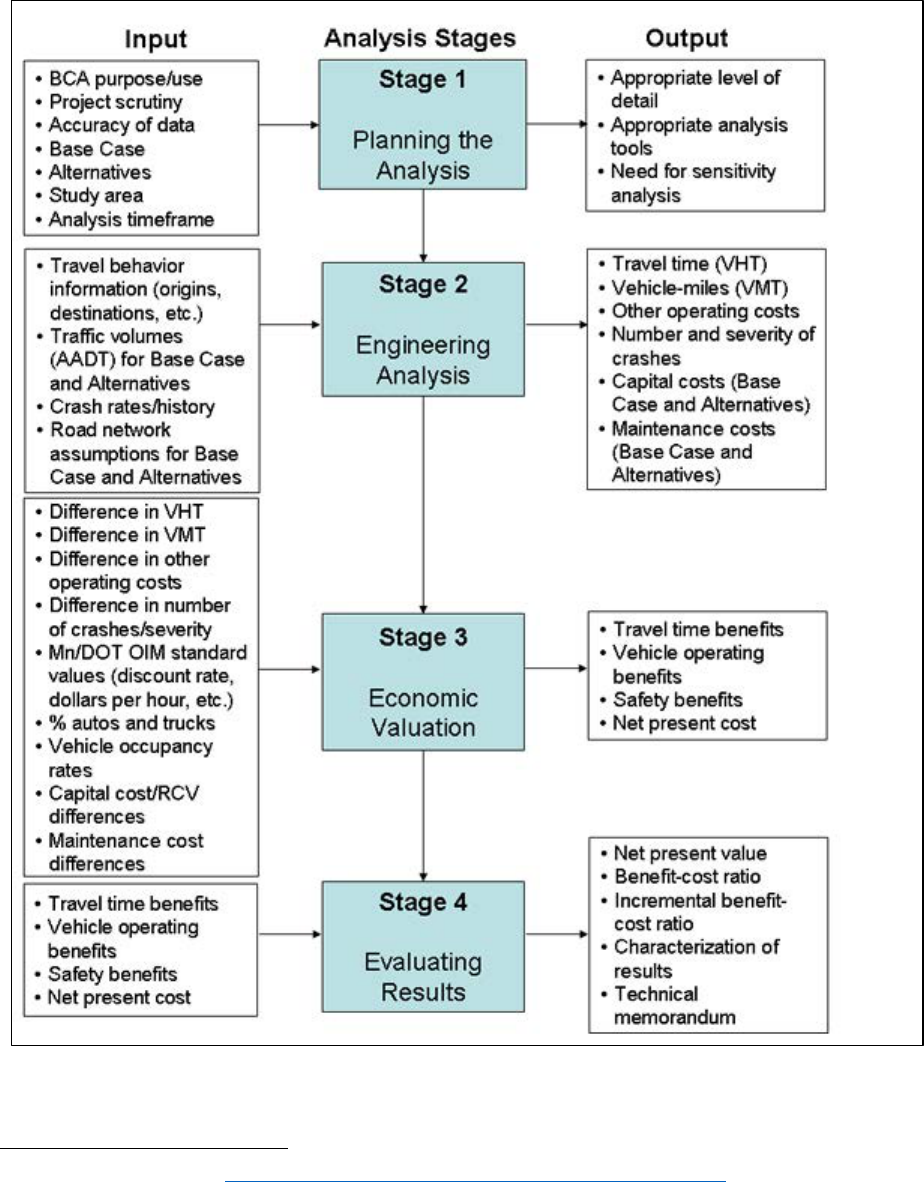
20
Figure 2: Minnesota DOT CBA Process
13
Each stage includes several sub-tasks. As part of the initial scope and project planning, the purpose
of the analysis needs to be defined. Data availability must be assessed because it will determine
13
Source: Minnesota DOT, http://www.dot.state.mn.us/planning/program/benefitcost.html
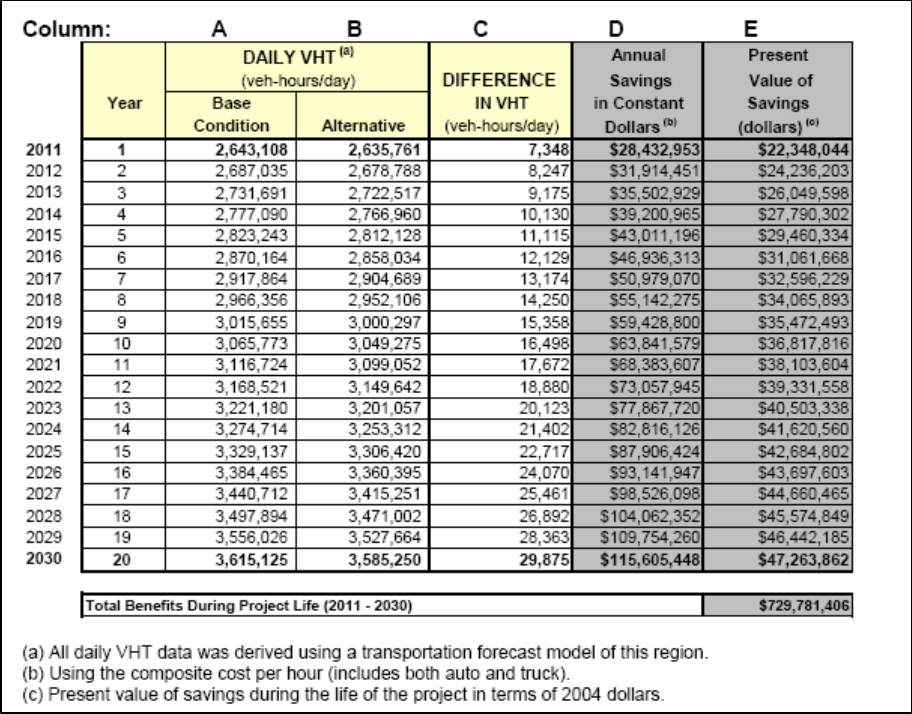
21
the level of detail that is feasible. Initial work should define the base case and alternatives it will
be compared to and the timeframe (construction, benefits lifecycle) the analysis should cover.
Once these decisions have been made, the salient data must be collected. The next step is to analyze
the alternatives relative to one another and the base case. This analysis should focus on benefits
that arise from changes in travel times, vehicle operations, and safety, and the costs including
construction, maintenance, and minor rehabilitation. Deriving present value calculations requires
monetization of costs and benefits. Minnesota DOT’s guidance suggests quantifying highway user
benefits (e.g. vehicle miles travelled, vehicle hours travelled, safety) and leveraging the resulting
calculations to make comparisons among the alternatives and base case. Once the benefits and
costs of the alternatives for the specified period of analysis have been identified, the next step is
to aggregate and convert dollar amounts using present value calculations (formula and details are
discussed later). Figure 3 is an example the Minnesota DOT provides that relates to benefits
derived from vehicle hours per day. Figure 4 summarizes the total benefits that users might derive
from a highway project including vehicle miles travelled, vehicle hours travelled, and safety.
Figure 3: Minnesota DOT Example Benefit Calculation
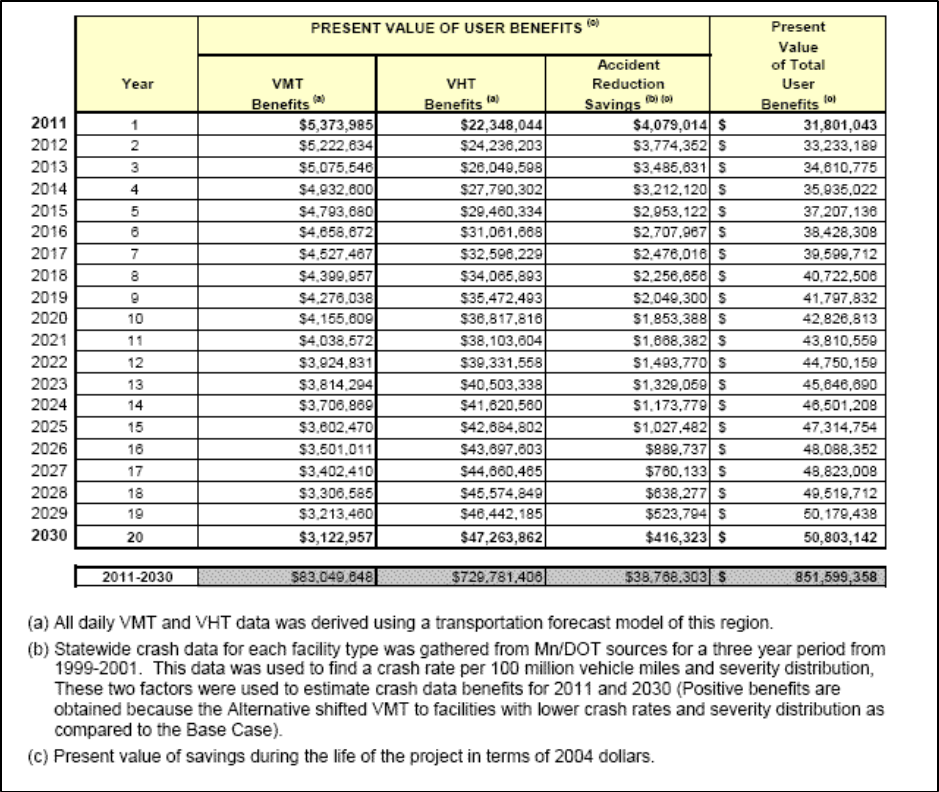
22
Figure 4: Minnesota DOT Total User Benefits
Next, the base case is compared to the alternatives by calculating how they differ from one another
in terms of highway user metrics. To facilitate comparisons, those differences are converted to
dollar amounts, which in turn are adjusted to present value. The total user benefits for each scenario
equals the sum of individual benefits calculations. Cost calculations allocate expenditures across
the project’s life and/or period of analysis for construction and associated maintenance. Whatever
value remains at the end of the period of analysis is the remaining capital value. This is calculated
by determining the percentage of remaining useful life at the last year of the analysis. Figure 5
illustrates one method for calculating total project costs.
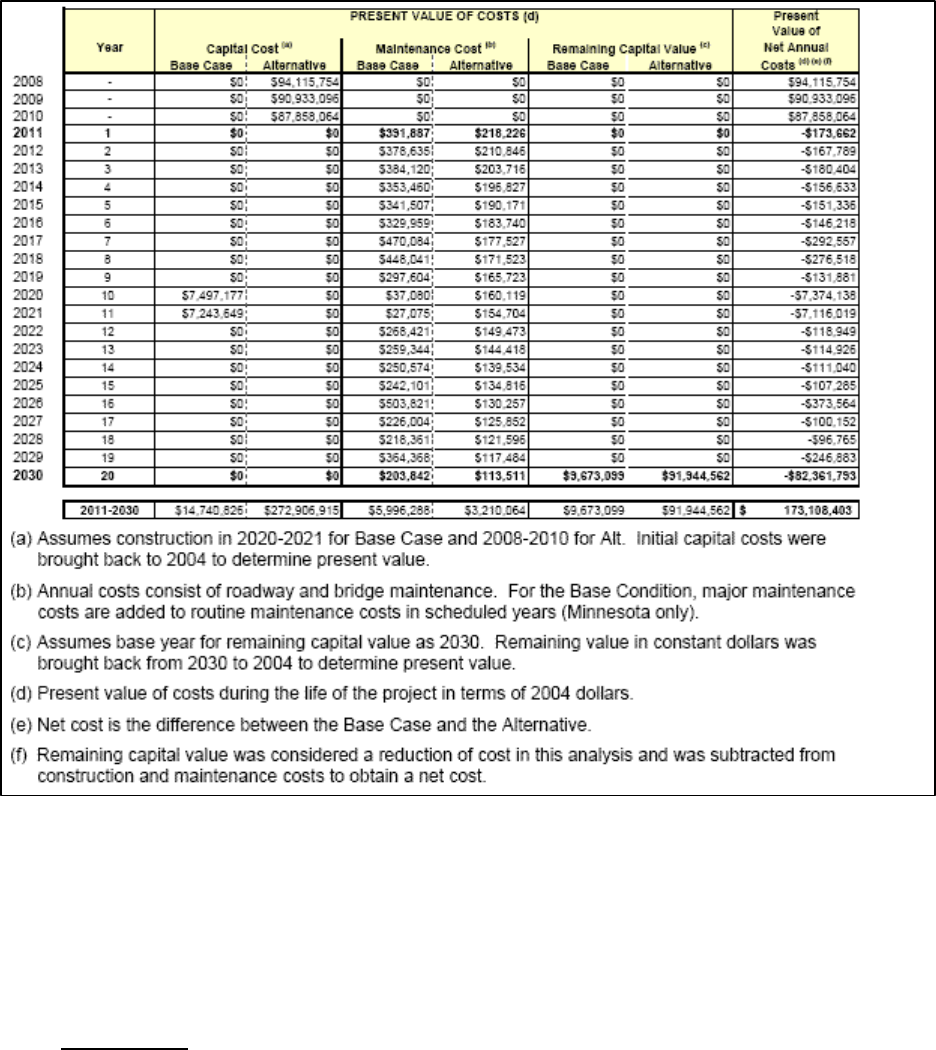
23
Figure 5: Minnesota DOT Example Cost Calculation
Results can be evaluated using several approaches. Net present value (NPV), Benefit-Cost Ratio,
and Incremental Benefit-Cost Ratio are often used to contrast the alternatives from an economic
perspective. Payback period and internal rate of return can be used as well. NPV discounts all
benefits and costs and then subtracts costs from benefits. The following equation can be used to
calculate the present value of benefit and cost flows. Results are then summed for multiple benefits
and/or costs:
!" #
$
%
&' ( )*
&%+,*
Where: PV = present value
B = benefit (cost)
N = year benefit (cost) is incurred
o = year to which discounting is occurring

24
d = discount rate
14
Thus, -!" # ./.!"
0
1 !"
2
Where: PV
b
= present value of benefits
PV
c
= present value of costs
If benefits are greater than costs, the NPV is positive. This would suggest a project may be worth
investigating further and potentially undertaken. When a state transportation agency compares
project alternatives, in general it should move forward with the project having the highest NPV.
But there is a caveat to this statement. As the FHWA notes, “Policy issues, perceived risk, and
funding availability may lead to the selection of an alternative with a lower, positive NPV.” That
is, other variables — which are not factored into CBA — may dictate project selection. The FHWA
also observes that benefit-cost ratio (BCR) is another measure that can be used. It is applicable if
there are funding issues that must be considered. To calculate BCR, the benefits are discounted in
the numerator and the agency investment cost discounted in the denominator.
$34 #
/!"
0
/.!"
2
After calculations are completed, a project recommendation can be made. If multiple alternatives
are being considered, the Incremental Benefit-Cost Ratio can be used. The Incremental Benefit-
Cost Ratio compares the change in present value between two alternatives. Alternative project
scenarios are ordered from least to most expensive. The first round of analysis compares only the
first two options. These options are termed the defender and challenger, with the challenger being
the more expensive alternative. The Incremental Benefit-Cost Ratio formula is applied to contrast
projects:
5$34 #
&/.!"
06)
1 /.!"
067
*
&/.!"
26)
1 /.!"
267
*
Where: IBCR = Incremental Benefit-Cost Ratio
PV
b,d
= present value of defender benefits
PV
b,f
= present value of challenger benefits
PV
c,d
= present value of defender costs
PV
c,f
= present value of challenger costs
The difference in the projects’ net benefits is divided by the difference in their net costs. If the
IBCR is greater than or equal to 1.0, it means the benefits of the challenger are equal to or greater
than its increase in costs. If this occurs in the next round of analysis, the current challenger
becomes the defender and is compared to another project. If the IBCR is less than 1.0, the current
defender is retained, and the new challenger is the next alternative on the project list. Comparisons
14
TIGER grants use a 7 percent rate from OMB Circulars A-4 and A-94; an alternative analysis is also allowed with
3 percent. The Congressional Budget Office and General Accounting Office use the rate of marketable Treasury
securities with maturities similar to the length of the project in question (Zhuang et al. 2007).

25
of challengers and defenders are made until all Alternatives have been considered. The surviving
defender is the most economically efficient.
15
Often, state transportation agencies select their preferred evaluation tool; multiple tools can be
used if agency staff think they will improve comparisons. The Transportation Economics
Committee lists several additional measures that can be used to evaluate proposed projects. The
Internal Rate of Return (IRR) is the discount rate that results in the net present value of project
cash flows equal to zero. Projects with a high IRR are considered to have greater value. The
Payback Period is the amount of time required for the cumulative benefits to equal cumulative
costs (both discounted to present value). Last, Cost Effectiveness compares discounted benefits of
alternative projects with the assumption of budgetary constraints. This measure can also be used
to quantify the discounted costs needed to reach a specified benefit.
TIGER Discretionary Grants are an example of a federal grant program that emphasizes CBA. The
U.S. DOT’s 2013 Notice of Funding Availability for TIGER grants noted:
Each applicant should provide evidence that the expected benefits of the project
justify the costs (recognizing that some costs and benefits are difficult to quantify).
If it is clear that the benefits do not justify the costs, the Department will not award
a TIGER Discretionary Grant to the project.
CBAs submitted as part of a TIGER proposal should include the following components:
• Project Summary
• Monetized estimates of benefits and costs
• Replicable Methodology
• Demonstration of independent utility
16
Figure 6 provides an example of a simple CBA calculation used in a TIGER grant proposal. It
shows information from the CBA and the results.
15
http://www.dot.state.mn.us/planning/program/benefitcost.html
16
Information from webinar presented by the Office of Assistant Secretary for Transportation Policy in the U.S.
Department of Transportation.
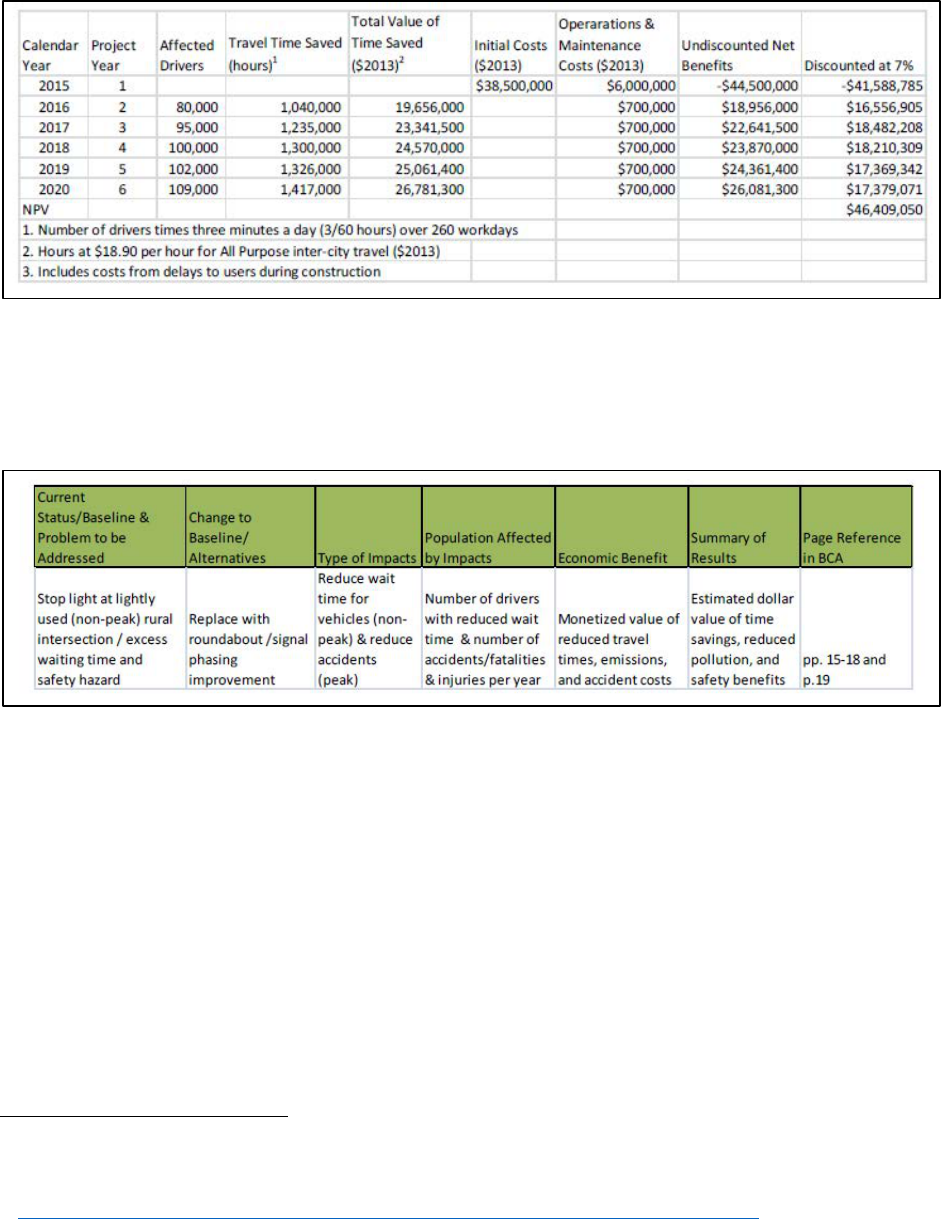
26
Figure 6: Example Cost Benefit Analysis Calculation
17
As the TIGER CBA guidance notes, one strategy to effectively communicate the results of a CBA
to wider audiences that are not well-versed in the technical aspects of CBAs is to build a project
matrix that summarizes the findings. Figure 7 is an example from TIGER CBA guidance.
Figure 7: CBA Project Matrix
18
Programs such as the Transportation Infrastructure Finance and Innovation Act (TIFIA) require a
CBA to qualify for federal credit assistance.
19
The FHWA notes that at a minimum “a project's
public and private benefits would be required to exceed the sum of its public and private costs.”
20
Thus, CBA is used to demonstrate whether a project surpasses that threshold.
It is often challenging to distinguish between economic impact studies
21
and CBAs. According to
TIGER grant guidance, CBA measures benefits and costs to society by assigning dollar values. An
economic impact analysis, conversely, measures the dollar value of a specific project’s impacts
(e.g., number of jobs created). It is typically a locally focused analysis that evaluates a project’s
effects on economic activity rather than measuring overall social improvement:
Economic impacts are the effects a project or policy has on the economy of a
designated project area, measured in terms of the change in business sales, jobs,
17
TIGER BCA Guidance, U.S. Department of Transportation.!
18
TIGER BCA Guidance, U.S. Department of Transportation.!
19
TIFIA provides credit assistance for surface transportation projects.
20
http://www.fhwa.dot.gov/ipd/tifia/technical_resources/federal_credit_policy_paper/ch3.aspx
21
See Kreis, Howell, and O’Connell (2006) for an examination of several options for assessing economic impacts of
proposed transportation investment in Kentucky.

27
value added, income, or tax revenue. These effects are sometimes referred to as
“economic development impacts.” Whereas Benefit-Cost Analysis is an exercise to
determine an action's social welfare effects (compared to costs), Economic Impact
Analysis is an exercise to determine how a project or policy affects the amount and
type of economic activity in a region.
22
One way to differentiate economic impact analysis from CBA is by thinking about the questions
they attempt to answer:
• CBA: is society better off by undertaking the project versus doing nothing?
• Economic Impacts: how will the economy change due to a project?
23
Sallman et al. (2012, Table 2-3) looked at several examples of benefits and noted whether CBA or
economic impact analysis explicitly consider them. Table 6 has been reproduced from their piece:
Table 6: Comparison of CBA and Economic Impact Analysis
Type of Benefit
Direct Benefit
Indirect Benefit
Induced Benefit
Example of Benefit
Reduction in
corridor travel
times.
New businesses are
attracted to the corridor by
the improved corridor
performance.
Employees of the new
businesses spend their
incomes at other regional
businesses.
Considered in CBA
Yes
No
No
Considered in
Economic Impact
Analysis
Yes
Yes
Yes
An example of economic impacts runs as follows: building a new road will entice businesses to
relocate near it; as businesses move into the area, new jobs are created and tax revenues increase;
in turn, local residents will enjoy the better transit access which connects them to their new jobs.
CBA is a widely-accepted method of comparing projects options. Data requirements are contingent
on the project in question and which benefits and costs are identified for the project. Identifying a
comprehensive list of these and costing them appropriately will ensure a CBA is valid. Multiple
evaluation criteria can be used to evaluate projects. The information they generate gives decision
makers project-specific information they can use to select and implement projects that will provide
the greatest benefit levels to the constituencies affected.
CHAPTER FOUR: COST BENEFIT ANALYSIS APPROACHES
The FHWA made several efforts to develop CBA tools in the 1990s. While there are no longer
active links to these models online, briefly reviewing their capabilities contextualizes the
development of similar tools today. The Sketch-Planning Analysis Spreadsheet Model (SPASM)
was one of these early models;
24
it was a spreadsheet for use in multimodal analysis at the sketch
22
http://bca.transportationeconomics.org/home/bca-vs-economic-impact-analysis
23
http://bca.transportationeconomics.org/home/bca-vs-economic-impact-analysis
24
For more on SPASM, see Findley et al. (2007) p. 7-9.

28
planning detail level. SPASM was a precursor to the Surface Transportation Efficiency Analysis
Model (STEAM), which assessed multimodal transportation alternatives and approaches to travel
demand. It used travel demand models and outputs to analyze projects such as corridor plans
(Coley, 2012). STEAM focused on regional multimodal analysis. Benefits considered in STEAM
included travel time, vehicle costs, emissions, noise, and energy consumption, whereas the costs
focused on were the initial capital costs and operating and maintenance costs. Other impacts were
also factored in, such as congestion and job impacts. Results were presented as net present value
calculations or benefit-cost ratios.
Given the widespread use of CBA in transportation and other sectors, there are a number of current
applications that can be used to perform CBA. This research involved summarizing and
commenting on a number of these applications; they are listed below. Also provided are any costs
and relevant links. Additionally, the Transportation Economics Committee of TRB describes these
models and provides an example of each.
25
These models can aid policymakers interested in
comparing project alternatives by giving them a more representative look at the benefits and costs
associated with each choice. Used appropriately, these models will lead to improved, cost efficient
project selection and safer, improved travel outcomes for users.
Highway Economic Requirements System (HERS-ST) (Free)
Available at: https://www.fhwa.dot.gov/infrastructure/asstmgmt/hersrprep.cfm
The Highway Economic Requirements System — State Version (HERS-ST) is an FHWA software
program that is an extension of the national-level model used to predict the level of investment
required to meet specified highway performance measures.
HERS-ST is an engineering/economic analysis (EEA) tool that uses engineering
standards to identify highway deficiencies, and then applies economic criteria to
select the most cost-effective mix of improvements for system-wide
implementation. HERS-ST is designed to evaluate the implications of alternative
programs and policies on the conditions, performance, and user cost levels
associated with highway systems. The model will provide cost estimates for
achieving economically optimal program structures, as well as predict system
condition and user cost levels resulting from a given level of investment.
26
HERS-ST is linked to the Highway Performance Monitoring System (HPMS). It can be used to
estimate the highway performance that would be expected from different levels of investment. The
program can consider capital projects focused on addressing issues on the highway system such as
capacity and condition. HERS-ST can select improvement scenarios where the benefits exceed the
costs. Scenarios can be developed using different criteria:
• Given a specified level of funding, determine the best project combinations from an
economic perspective
• Determine the minimum level of spending to achieve performance measures
25
http://bca.transportationeconomics.org/models
26
https://www.fhwa.dot.gov/infrastructure/asstmgmt/hersindex.cfm

29
• Identify the project combinations and spending levels needed to undertake all projects
that meet a certain economic target such as a benefit cost ratio
HERS-ST uses interview screens to assist with data entry and verification. Inputs from the HPMS
format are accepted for highway sections. After data are input, the model identifies future condition
and capacity issues and alternatives, corrects for these, and performs a CBA for each. Examining
different scenarios and the numerous ways of displaying results offers the user greater flexibility
when conducting analyses, which can include an incremental benefit-cost approach. Benefits that
can be evaluated include travel time, vehicle operating costs, reduction in crashes, emissions,
agency costs for maintenance and operation, and residual values. Costs are limited to right-of-way
acquisition and construction costs. Funding constraints or specified performance measures can be
used to drive the analysis. A user’s guide and examples of the software in action can be found on
the HERS-ST website.
27
Figure 8: HERS-ST Screenshot
BCA.NET (Free)
Available at: http://bca.decisiontek.com/
BCA.Net is home to the FHWA’s benefit-cost analysis tool, which can support the highway project
decision-making process. BCA.NET is a web-based application that lets users compare alternative
approaches for managing and improving highways. BCA.NET is supported by the FHWA Asset
Management Evaluation and Economic Investment Team:
The BCA.Net system enables users to: manage the data for an analysis; select from
a wide array of sample data values; develop cases corresponding to alternative
strategies for improving and managing highway facilities; evaluate and compare
27
See also: http://www.gao.gov/products/GAO-01-299
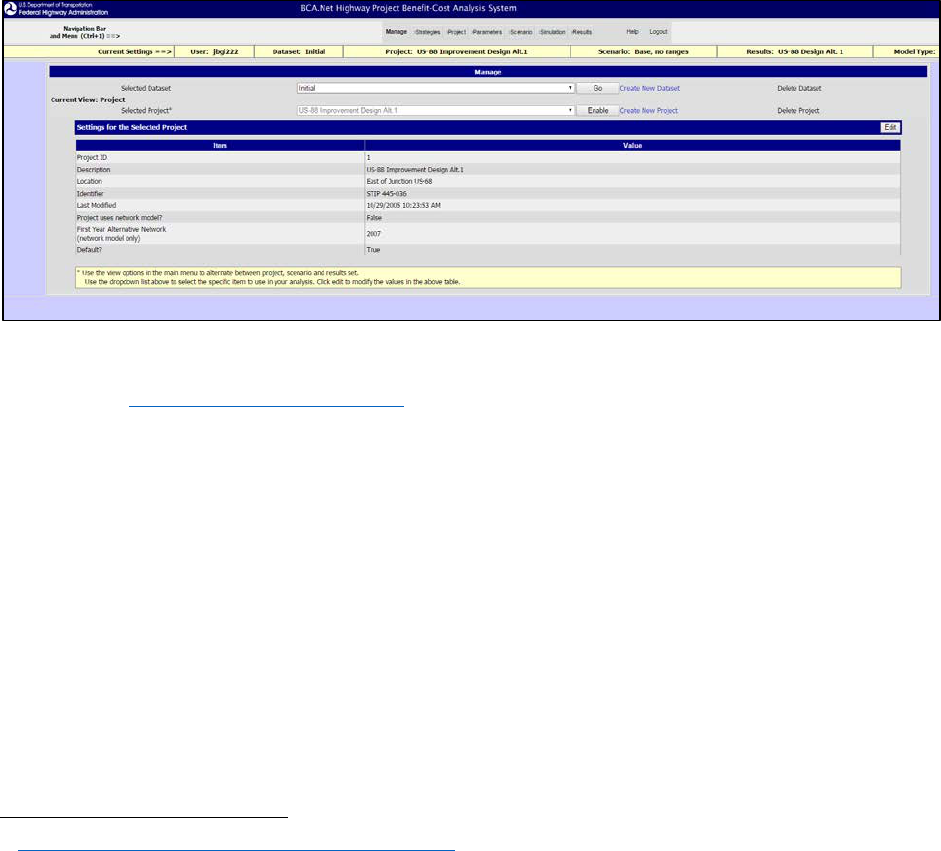
30
the benefits and costs of the alternative strategies; and, provide summary indicators
for informing investment decisions.
28
BCA.NET input options include capital cost, physical characteristics, performance impacts, and
forecasted travel demand. Design, project timing, and project alternatives can also be factored into
analysis. BCA.NET is most appropriate for small- to medium-sized highway capacity projects that
involve significant resources, but which do not necessarily alter traffic patterns (Coley, 2012).
During analysis, the user can specify needed maintenance during the project’s lifecycle. BCA.NET
then calculates the present value of benefits and costs, which gives the user several measures to
compare alternatives, including net present value, internal rate of return, and benefit-cost ratio.
BCA.NET is free and, because of its web-based format, does not require software installation. A
workshop is available to interested users that provides information on Highway Investment
Analysis, including the BCA.NET tool. Workshop sessions are held at various points throughout
the year.
Figure 9: BCA.NET Screenshot
TREDIS Multimodal Benefit-Cost Analysis Tool (Free)
Available at: http://www.tredis.com/mbca
The TREDIS Multimodal Benefit-Cost Analysis (MBCA) is a web-based program that compares
the benefits and costs of transportation projects. It includes passenger and freight transport across
all modes. MBCA meets USDOT requirements and can be used to support grant applications in
addition to executing project assessments.
MBCA lets users conduct multimodal analysis that covers air, water, rail, and highway. Even non-
motorized methods of transportation are included (e.g., pedestrian and bicycle).
MBCA is unique in that it covers both passenger and freight transportation
spanning all modes – highway, rail, air, and marine – and it also includes pedestrian
and bicycle modes. It is designed to be consistent with USDOT guidelines, making
it useful for multimodal project assessments, grant applications, and education
28
http://bca.transportationeconomics.org/models/bca-net
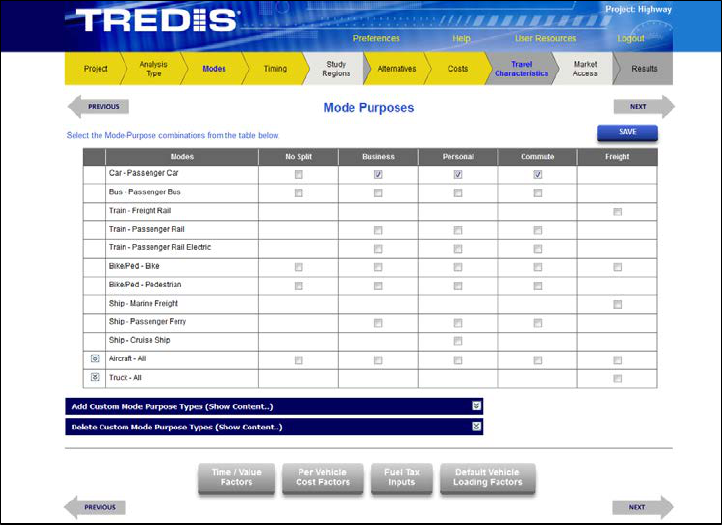
31
programs. MBCA is set up with standard U.S. and Canadian values for user benefit,
which are not tied to any specific study area. (Lawrence et al., 2014, p. 3-3)
TREDIS notes that the MBCA tool is useful for three project types: 1) single mode projects with
one or more alternatives, 2) single mode projects that impact other modes, and 3) multimodal
projects that cross modes (e.g., combination transit/highway corridor project). MBCA inputs
include project costs and timelines and common benefits, such as changes in congestion, safety,
and travel distance. MBCA accounts for benefits that accrue directly to users as well as
externalities, such as emissions and business productivity. TREDIS offers additional tools that
may come with a cost.
Figure 10: TREDIS MBCA Screenshots

32
Figure 11: TREDIS MBCA Results

33
MicroBENCOST ($50)
Available at: http://mctrans.ce.ufl.edu/
MicroBENCOST was created by the National Cooperative Highway Research Program (NCHRP)
to perform CBA. Developed in the early 1990s, the program is a DOS application, but also runs
with Windows. It is distributed by the Texas Transportation Institute and the McTrans Center at
the University of Florida:
MicroBENCOST is a computer program for analyzing benefits and costs of a wide
range of highway improvements. It also can allocate corridor traffic and calculate
forecasted traffic volumes. The program is capable of analyzing seven categories
of projects: added-capacity, bypass, intersection/interchange, pavement
rehabilitation, bridge, safety, and highway-railroad grade crossing.
In general, the program compares the motorist costs in the existing situation, the
“without improvement” alternative, to the motorist costs if the improvement is
completed, the “with improvement” alternative. In all cases, the “without
improvement” alternative includes an existing route and an optional alternate route.
Except for new location projects, the “with improvement” alternative includes a
proposed route that replaces the existing route and an optional alternate route. For
new location projects, the “with improvement” alternative includes an existing
route, a proposed route, and an optional alternate route. The proposed route does
not replace the existing route in a bypass project although it may take some of the
traffic off the existing route.
29
Users can examine highway improvement projects with MicroBENCOST. Benefits that may be
factored into analysis are travel time, vehicle costs, and accidents. Impacts to vehicles can be
estimated across nine different passenger types and nine different truck types. Cost analysis is
based on initial project cost, residual value at the end of the analysis period, and
rehabilitation/maintenance costs. Results are in the form of NPV calculations, internal rate of
return, or benefit cost ratios.
StratBENCOST ($55)
Available at: http://mctrans.ce.ufl.edu/
Also available at: http://apps.trb.org/cmsfeed/TRBNetProjectDisplay.asp?ProjectID=498
StratBENCOST combines aspects of HERS and MicroBENCOST into CBA. It was developed as
part of NCHRP Project 2-18(4). StratBENCOST’s lifecycle analysis can run 30 years, and the user
can specify when benefits start to accumulate. The program can analyze two project types: a road
segment with no significant traffic diversions or an investment with larger network implications
that diverts traffic. StratBENCOST lets users compare up to 20 alternatives against the base case.
The program also generates random variables if the user inputs a median or tenth and ninetieth
percentiles. It can also generate probability distributions using Monte Carlo simulations to show a
range of values. StratBENCOST calculates benefits like travel times, vehicle costs, accidents, and
29
http://mctrans.ce.ufl.edu/store/description.asp?itemID=166

34
emissions; costs include capital, right-of-way, maintenance, and lifecycle, among others. The
program calculates NPV, IRR, BCR, and total benefits or total costs:
StratBENCOST32 is designed as a decision support tool for state and local
transportation agencies engaged in multi-year strategic planning and budgeting for
highways. StratBENCOST32 consists of two models, one for network analysis and
one for single segment analysis. Each model incorporates risk analysis techniques
to account explicitly for the inherent uncertainty in the methodology and the data
underlying the analysis. The conceptual basis for each model is described below.
Network Benefit Cost Analysis Model - Few highway projects can be accurately
evaluated without studying their effect on the network of highways and other roads
around them, particularly in dense urban settings. Sophisticated network analysis
models have been developed to analyze the effects a new roadway improvement
will have on a developed network. StratBENCOST32 utilizes the aggregate results
of these models that include daily vehicle miles of travel and vehicle hours of travel
to develop economic criteria. Standard roadway characteristics are applied to each
roadway type, simplifying the analysis.
Single Segment Benefit Cost Analysis Model - Many highway projects do not
significantly affect highways around them, particularly in sparsely populated or
rural areas. This strategic level-planning model analyzes these situations in a
manner that is similar to project modeling, without the same level of detailed data
input.
30
California Life-Cycle Benefit-Cost Analysis Model (Cal-B/C) (Free)
Available at: http://www.dot.ca.gov/hq/tpp/offices/eab/LCBC_Analysis_Model.html
Cal-B/C is an excel spreadsheet used to perform CBA for highway and transit projects. Booz-Allen
Hamilton developed it for the California Department of Transportation (Caltrans). Cal-B/C was
developed “in the mid-1990s to facilitate the assessment of many projects in a short time frame
using a standardized approach” (Williges & Mahdavi, 2008, p. 79). Projects based in California
have minimal data input requirements due to prepopulated default values. If agencies in other states
decide to use the tool, these values can be overridden as desired.
The Economic Analysis Branch (of California DOT) routinely conducts life-cycle
benefit/cost analysis for proposed state highway and public transit projects. Such
analysis is performed using Cal-B/C, a PC-based spreadsheet model developed by
the Branch and outside consultants. Cal-B/C can be used to analyze many types of
highway construction and operational improvement projects, as well as some
Intelligent Transportation System (ITS) and transit projects.
31
Cal-B/C analyzes prospective corridor projects against existing transportation infrastructure,
including highways and transit as well as Intelligent Transportation Systems (ITS). The types of
projects that Cal-B/C can evaluate are listed below in Table 7 (Findley et al., 2007, p.4).
30
http://mctrans.ce.ufl.edu/store/description.asp?itemID=524
31
http://www.dot.ca.gov/hq/tpp/offices/eab/LCBC_Analysis_Model.html

35
Table 7: Cal-B/C Projects
Highway Capacity
Expansion
Transit Capacity
Expansion
Operational
Improvements
Transportation
Management
Systems
General Highway
HOV Lane
Passing Lane
Interchange
Bypass
Pavements
Passenger Rail
Light Rail
Bus
Auxiliary Lane
Freeway Connector
HOV Connector
HOV Drop Ramp
Off-Ramp Widening
On-Ramp Widening
Ramp Metering
Signal Coordination
Incident Management
Traveler Information
Arterial Signal
Management
The spreadsheet contains 10 work sheets and a cover sheet. Users enter information in the first
four sheets. Color coding identifies where data are needed, with green denoting user input and red
indicating default. The inputs required for highway projects include (Williges & Mahdavi, 2008,
p. 81):
• Number of general and HOV lanes
• Estimated free-flow speed
• Length of highway segment
• Average daily traffic (ADT) and hourly HOV traffic
• Three-year collision data for the facility
• Statewide average collision rates
Benefits that may be derived with Cal-B/C are travel time, vehicle costs, and accident and emission
reductions, while the costs it computes are focused on a total life investment along with operating
and rehabilitation costs. Costs are needed for various components depending on the type of project
including (Williges & Mahdavi, 2008, p. 83):
• Right-of-way
• Construction
• Mitigation
• Project supports
• Maintenance and operation
• Rehabilitation
The program captures benefits for current traffic as well as any benefits that are brought about by
an alternative project. The period of analysis can run for 20 years, and it generates results in the
form of NPV, benefit-cost ratio, internal rate of return, and payback period. Default values for fuel,
wages, and other variables are California-specific, but can be modified.

36
Figure 12: Cal-B/C Screenshots
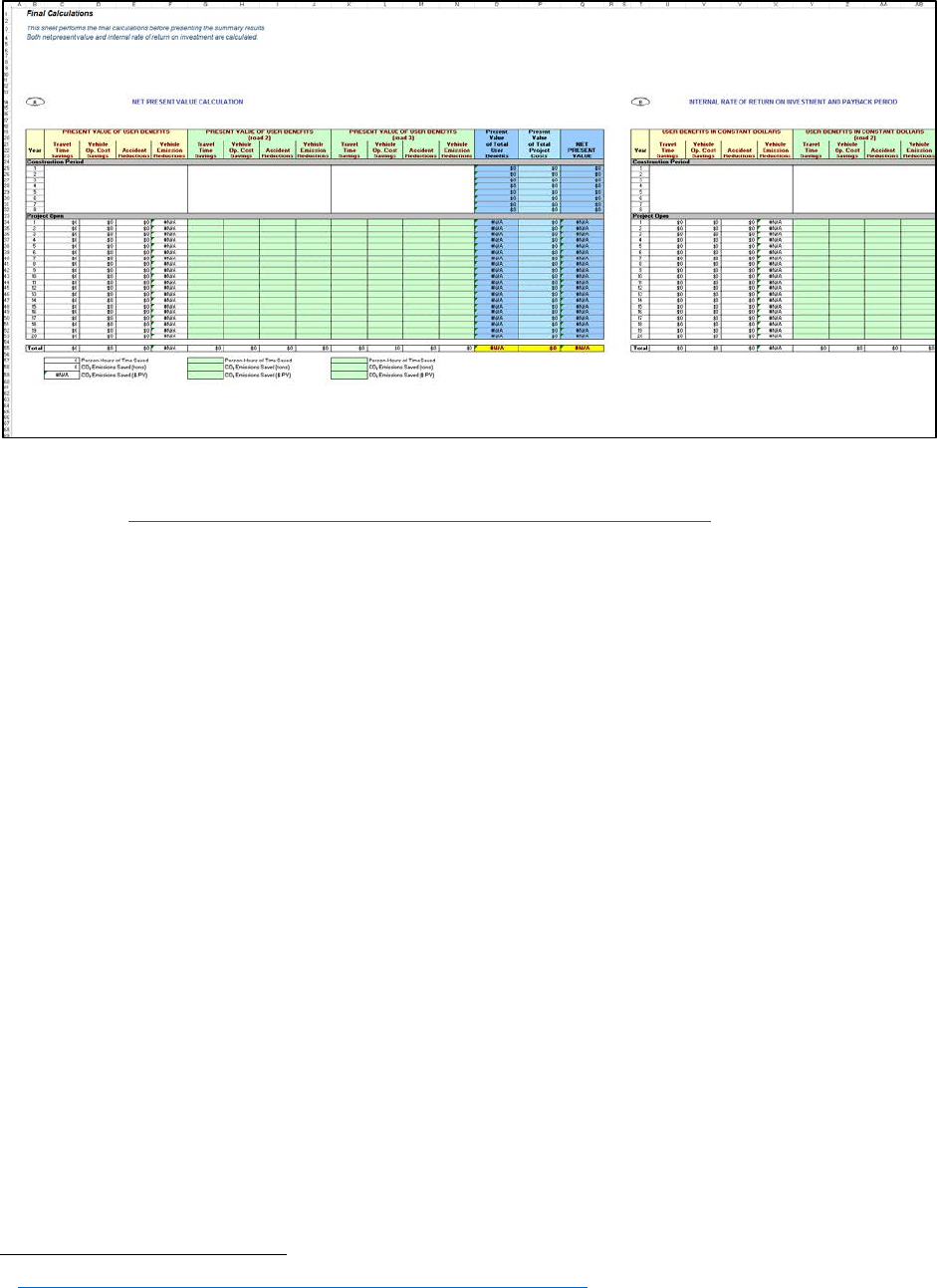
37
Tool for Operations Benefit/Cost (TOPS-BC) (Free)
Available at: http://www.ops.fhwa.dot.gov/plan4ops/topsbctool/index.htm
TOPS-BC is a sketch-planning tool the FHWA developed. It supports CBA for Transportation
System Management and Operations (TSM&O) strategies. TOPS-BC was developed with input
from practitioners and is spreadsheet-based. It analyzes the impact of selecting different TSM&O
approaches, identifies the appropriate methodology for CBA based on the type of analysis desired,
and estimates lifecycle costs and benefits.
TOPS-BC provides:
• The ability to analyze many TSM&O strategies and to investigate the expected range of
impacts associated with previous deployments
• A screening mechanism to help identify appropriate tools and methodologies for
conducting a B/C analysis based on analysis needs
• A framework and default cost data to estimate the life-cycle costs (including capital,
replacement, and continuing O&M costs) of various TSM&O strategies
• A framework and suggested impact values for conducting simple sketch planning level
B/C analysis for selected TSM&O strategies
32
All of TOPS-BC’s capabilities are included in one workbook, and color coded tabs assist users in
selecting the appropriate function. Default data, output, and user input are defined within each
sheet, also using color coded cells.
32
http://ops.fhwa.dot.gov/publications/fhwahop13041/fhwahop13041.pdf

38
Figure 13: TOPS-BC Screenshots
Trip Reduction Impacts of Mobility Management Strategies (TRIMMS) Model (Free)
Available at: http://www.nctr.usf.edu/abstracts/abs77805.htm
TRIMMS measures the social benefits created by transportation demand projects, with a focus on
emissions, safety, and fuel usage. Because it assesses cost effectiveness via sensitivity analysis,
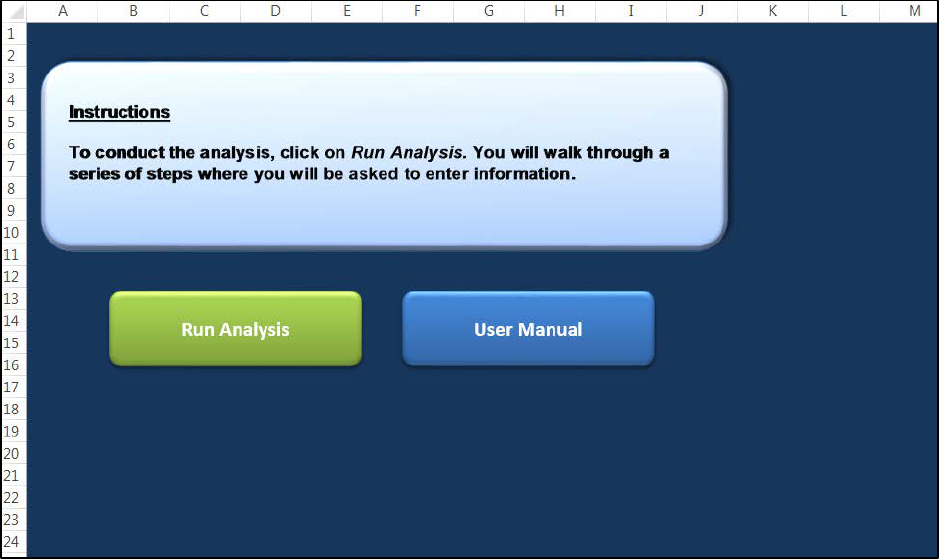
39
TRIMMS can be used to support transportation demand management, which is necessary to
comply with FHWA Congestion and Air Quality Improvement Program requirements.
TRIMMS© is a spreadsheet application that estimates the impacts of a broad range
of transportation demand management initiatives and provides program cost
effectiveness measures, such as net program benefits and benefit to cost ratio
indicators. TRIMMS© evaluates strategies directly affecting the cost of travel, like
public transportation subsidies, parking pricing, pay8as8you8go pricing, and other
financial incentives. TRIMMS© also evaluates the impact of strategies affecting
access and travel times and a host of employer8 based program support strategies,
such as flexible working hours, telecommuting and guaranteed ride home programs
(Concas & Winters, 2009, p. v).
Figure 14: TRIMMS Model Screenshot
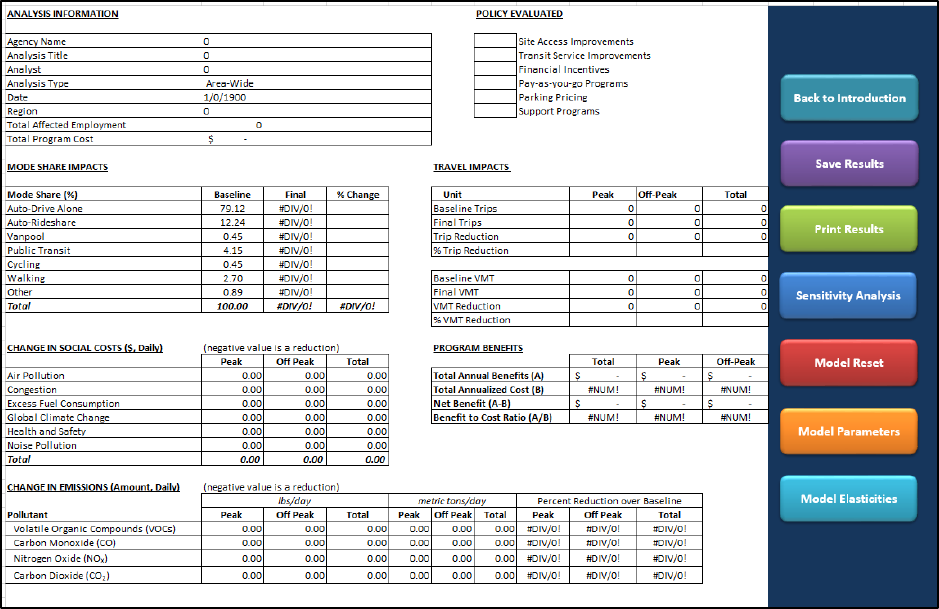
40
CHAPTER FIVE: IMPLEMENTATION AND CONCLUSION
This study documented historical trends in CBA as well as its purpose and basic functions. CBA
is an evaluation tool used to compare alternative project options and gauge if the discounted value
of benefits exceed the costs. Several metrics are used to make this judgment, such as NPV, Benefit-
Cost Ratio, and Incremental Benefit-Cost Ratio. CBA compares cumulative, discounted costs and
benefits over the lifecycle of the infrastructure projects being compared. Most CBAs follow similar
procedures. CBAs typically begin by defining the base case and identifying project alternatives
and setting scope of the analysis. From here, an analysis will determine project impacts (and
convert to dollar values where necessary), discount costs and benefits, compare net benefits, and,
based on these findings, put forward recommendations. In the transportation context, most benefits
are derived from travel time savings and crash reductions. Typical costs include construction and
subsequent maintenance. The calculations required for a CBA are relatively straightforward, but
users should keep some issues in mind when deciding whether performing one is appropriate. First,
CBAs are well-suited to large projects, projects that are designed to improve efficiency and not
meet other goals, and where environmental and social impacts are either negligible or measurable.
They are a preferred method for ranking alternative projects and are more methodologically robust
than worst-first rankings.
CBA is not appropriate to study the costs and benefits of large-scale initiatives that combine
multiple smaller projects in a single package. While CBA can trenchantly assess individual
projects, it is an acceptable means of examining a number of projects collectively. Similarly, CBA
should not be used if the goal of a project is to comply with a legal requirement. CBAs are of
41
limited use if potential costs or benefits are omitted, or if measuring certain elements such as travel
time savings or safety improvements proves difficult or impossible. Incomplete data can also
hinder analysis. CBA differs from economic impact analysis, which is an important distinction to
make. Economic impacts analyses measures the dollar value of a project (e.g., number of jobs
created), while CBA measures benefits and costs from a broader social perspective.
The increasing popularity of CBA stems partially from the federal government which, through a
series of executive orders, mandates that projects using public funds should focus on maximizing
benefits. As the use of CBA to evaluate projects and grant applications (e.g., TIGER Discretionary
Grants) continues to grow, it will be important for state transportation agencies to have knowledge
of CBA methodologies, especially if they want to remain competitive for federal funding. Several
state DOTs already have CBA guidance in place or have developed templates to facilitate project
analysis. Having information on the costs of benefits of proposed projects can assist the Cabinet
with project selection and bring a renewed focus to cost efficiency by selecting projects that will
significantly benefit citizens of the Commonwealth. Several programs that can be used to perform
CBA were discussed to identify applications that KYTC could readily mobilize to execute CBAs.
Most of the programs discussed are either free or inexpensive. Some of the applications provide
detailed guidance and instruction to users, either through online documentation or through a
downloadable spreadsheet that contains directions.
To facilitate implementation of a CBA tool at KYTC, the research team studied each of the CBA
programs and spreadsheets detailed in Chapter 4. They identified applications with a user-friendly
approach to CBA which policymakers could become familiar with quickly and that would yield a
rapid CBA for projects. The Cal-B/C model is appealing because it is spreadsheet-based and lets
users input data easily. Many of the default settings are unique to California; thus, without
modifications this model would not be useful. The three applications that hold the most promise
are HERS-ST, BCA.NET, and TREDIS MBCA. HERS-ST is mainly an extension of the national
model for performance measures, but it is linked to the HPMS. It evaluates project combinations
based on specified funding levels and the amount of funding needed to comply with specific
requirements. BCA.NET is a web-based CBA tool developed by FHWA. It requires users to input
project cost, characteristics, and travel demand. FHWA notes that BCA.NET is most appropriate
for small- or medium-sized highway capacity projects. TREDIS MBCA is a free web-based CBA
program that can handle multiple modes. Users input project costs, timelines, and benefits, which
can include congestion reduction, safety improvements, and others. TREDIS has other tools
available that can be used to perform an economic impact analysis.
Building off of this research, the team developed a simple workbook application that KYTC
personnel can use run a CBA. The workbook contains instructions and calculations tabs. To
simplify calculations and reduce the number of user inputs, it considers a limited number of costs
(construction and maintenance) and benefits (travel time and crash reduction savings). Required
user inputs are: base and alternative construction costs, vehicle travel time savings, whether the
project is local or intercity, the number of drivers affected, and the anticipated crash reductions
(by severity of injury). The workbook calculates present value of costs and benefits using a seven
percent discount rate and makes both NPV and BCR available to the user. While this workbook is
straightforward, it is a tool that can quickly produce a CBA with a small number of inputs.

42
REFERENCES
Adler, Matthew, & Eric Posner. (1999). Rethinking Cost-Benefit Analysis. The Yale Law Journal,
109(2), 165-247.
Balducci, Patrick. (2012). Integrated Corridor Management Initiative: Demonstration Phase
Evaluation- San Diego Benefit-Cost Analysis Test Plan. U.S. Department of Transportation
Research and Innovative Technology Administration, FHWA-JPO-13-042.
Bartin, Bekir, Kaan Ozbay, & Nusrat Jahan. (2012). Benefit Cost Analysis of Highway Investment
Projects Using Regional Transportation Planning Models. Transportation Research Board Annual
Conference: Washington, D.C.
Beukers, Els, Luca Bertolini, & Marco Te Brommelstroet. (2012). Why Cost Benefit Analysis is
perceived as a problematic tool for assessment of transport plans: A process perspective.
Transportation Research Part A, 46. 68-78.
Brent, R.J. (1996). Applied Cost–Benefit Analysis. Edward Elgar Publishing: Cheltenham.
Coley, Nathaniel. (2012). Spotlight on Benefit-Cost Analysis. Federal Highways Administration
Publication, FHWA-HRT-12-003.
Concas, Sisinnio & Philip Winters. (2009). Quantifying the Net Social Benefits of Vehicle Trip
Reductions: Guidance for Customizing the TRIMMS Model. National Center for Transit Research,
Center for Urban Transportation Research, University of South Florida, Research Report BD 549
WO 52.
Economic Development Research Group. (2010). Benefit-Cost Assessment Guidance for
Evaluating Proposed Highway Tolling and Pricing Options for Oregon. Prepared for the Oregon
Department of Transportation. Retrieved from:
http://www.oregon.gov/ODOT/TD/TP/docs/tolling/benefit.pdf.
Eliasson, J. (2006). Forecasting travel time variability. Proceedings of the European Transport
Conference 2006: Strasbourg, France.
Federal Highway Administration’s Economic Analysis Primer on Benefit-Cost Analysis. Retrieved
from: http://www.fhwa.dot.gov/infrastructure/asstmgmt/primer05.cfm.
Findley, Daniel, John Stone, Shannon Fain, & Robery Foyle. (2007). NCDOT Benefit/Cost
Analysis for Planning Highway Projects. North Carolina State University Research Report for the
North Carolina Department of Transportation, FHWA/NC/2006-43.
Fosgerau, M., Hjorth, K., Brems, C., Fukuda, D. (2008). Travel time variability – definition and
valuation. DTU Transport: Copenhagen, Denmark.

43
Government Accountability Office. (2005). Highway and Transit Investments: Options for
Improving Information on Projects’ Benefits and Costs and Increasing Accountability for Results.
(GAO-05-172), Washington, D.C.
Guo, Jessica, Jie Zheng, Qi Gong, & Kevin White. (2008). Benefit-Cost Analysis for Evaluating
Inter-City Transit Investment. Midwest Regional University Transportation Center (University of
Wisconsin-Madison), MRUTC 08-03.
Hauer, Ezra. (2011). Computing what the public wants: Some issues in road safety cost-benefit
analysis. Accident Analysis and Prevention, 43, 151-164.
Homan, Anthony, Teresa Adams, & Alex Marach. (2014). A Statistical Analysis of the Role of
Benefit-Cost Analysis in Awarding TIGER Grants. Public Works Management and Policy, 19(1),
37-50.
Kreis, Doug, Brian Howell, & Len O’Connell. (2006). Early Stage Benefit Cost Analysis for
Estimating Economic Impacts. Kentucky Transportation Center Research Report, KTC-06-
11/SPR306-05-1F.
Kulkarni, Ram, Deb Miller, Rosemary Ingram, Chi-Wah Wong, & Julie Lorenz. (2004). Need-
Based Project Prioritization: Alternative to Cost-Benefit Analysis. Journal of Transportation
Engineering, 103, 150-158.
Lawrence, Michael, Paul Nguyen, Jonathan Skolnick, Jim Hunt, & Roemer Alfelor. (2014). Road
Weather Management Benefit Cost Analysis Compendium. Federal Highway Administration
Research Report, FHWA-HOP-14-033.
Levinson, D. (2002). Identifying winners and losers in transportation. Transportation Research
Record: Journal of the Transportation Research Board, 1812, 179–185.
Martens, Karel. (2011). Substance precedes methodology: on cost benefit analysis and equity.
Transportation, 38, 959-974.
Menendez, Jose Rafael, Salar Zabihi Siabil, Paul Narciso, & Nasir Gharaibeh. (2013). Prioritizing
Infrastructure Maintenance and Rehabilitation Activities Under Various Budgetary Scenarios:
Evaluation of Worst-First and Benefit-Cost Analysis Approaches. Transportation Research
Record: Journal of the Transportation Research Board, 2361, 56-62.
Minnesota Department of Transportation. Benefit-Cost Analysis for Transportation Projects.
Retrieved from: http://www.dot.state.mn.us/planning/program/benefitcost.html.
Peer, Stefanie, Carl Koopmans, & Erik Verhoef. (2012). Prediction of travel time variability for
cost-benefit analysis. Transportation Research Part A, 46, 79-903.

44
Sallman, Doug, Erin Flanigan, Krista Jeannotte, Chris Hedden, & Dorothy Morallos. (2012).
Operations Benefit/Cost Analysis Desk Reference. Federal Highway Administration Report,
FHWA—OP-12-028.
Schofield, J.A. (1987). Cost–Benefit Analysis in Urban and Regional Planning. Allen & Unwin:
London.
Section 1909 Commission Staff. (2007). Benefit-Cost Analysis in Public Sector Infrastructure
Investment Decisions. Paper prepared for the National Surface Transportation Policy and Revenue
Study Commission, U.S. Department of Transportation.
Sullivan, Edward, Joy Dahlgren, Glen Weisbrod, & Kazem Attaran. (2008). Web-Based Guide to
Transportation Benefit-Cost Analysis. Journal of Transportation Engineering, 134(7), 282-286.
Transportation Economics Committee. Transportation Research Board. Benefit-Cost Analysis.
Retrieved from: http://bca.transportationeconomics.org/home.
Veneziano, David, Laura Fay, Zhirui Ye, Dan Williams, & Xianming Shi. (2010). Development
of a Toolkit for Cost-Benefit Analysis of Specific Winter Maintenance Practices, Equipment, and
Operations. Wisconsin Department of Transportation Report prepared by Western Transportation
Institute, WisDOT 0092-09-08.
Williges, Chris, & Mahmoud Mahdavi. (2008). Transportation Benefit-Cost Analysis: Lessons
from Cal-B/C. Transportation Research Record, 2079, 79-87.
Zhuang, Juzhong, Zhihong Liang, Tun Lin, & Franklin De Guzman. (2007). Theory and Practice
in the Choice of Social Discount Rate for Cost-Benefit Analysis: A Survey. Asian Development
Bank, Economics and Research Department Working Paper Series 94.
